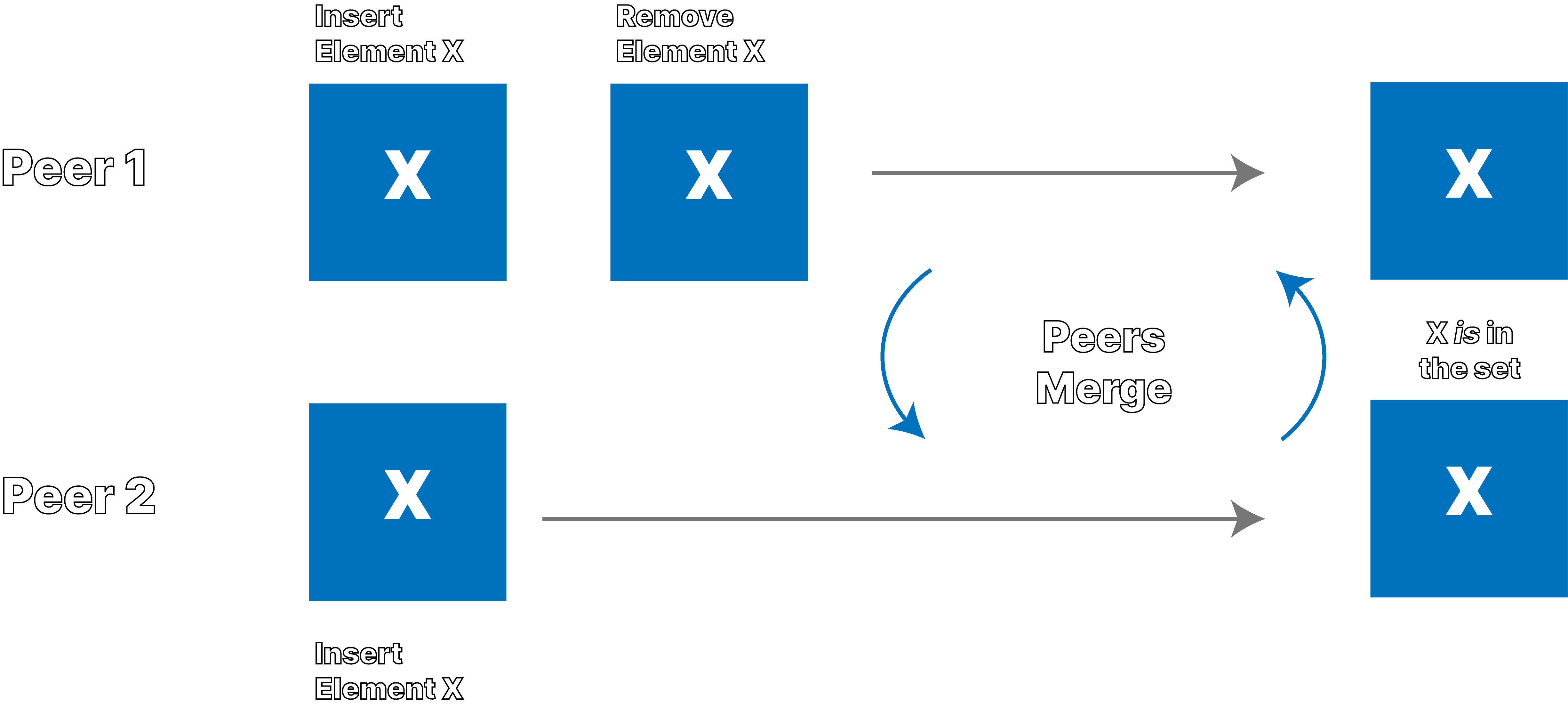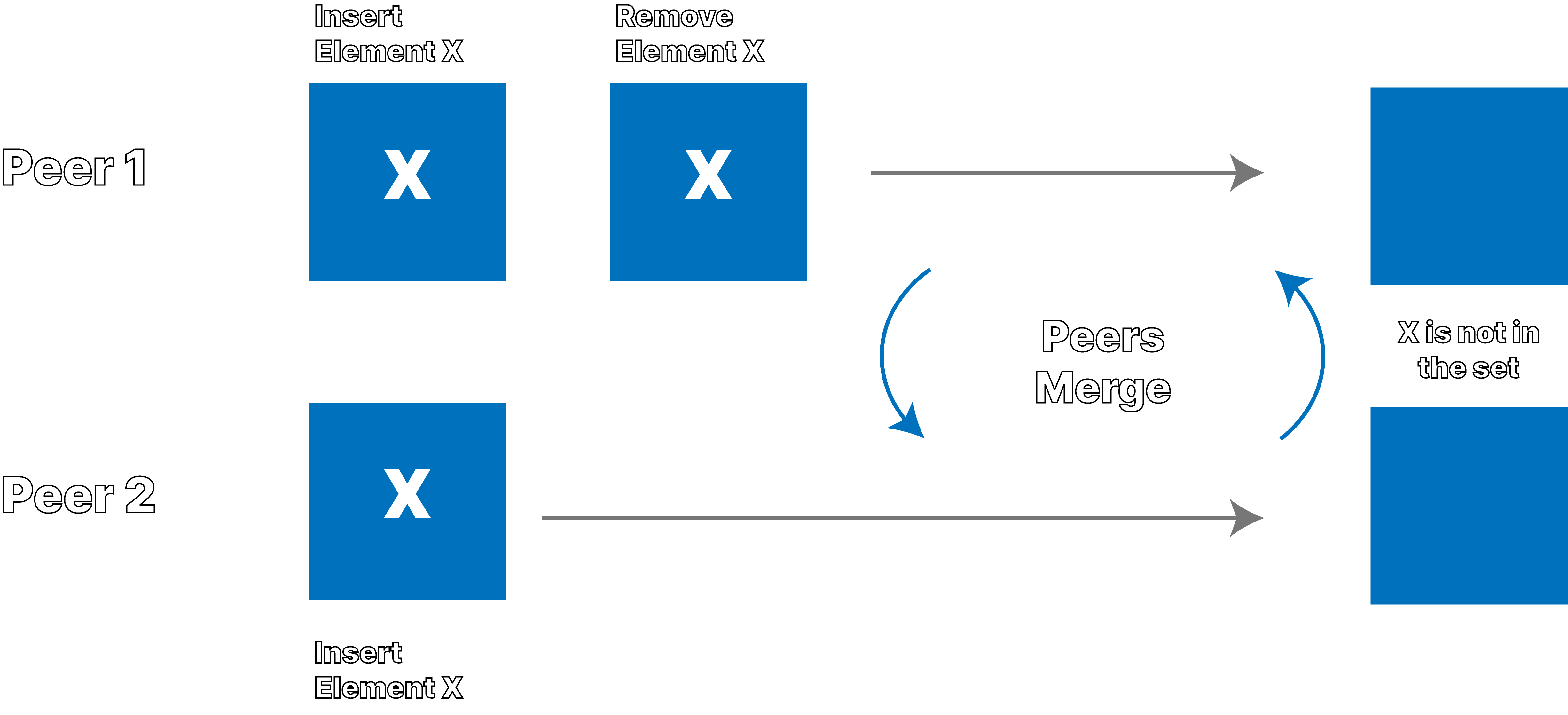Ditto is a database that puts theory to practice. Ditto's peer-to-peer data-structures based on CRDTs are deployed into real-world production use cases. As we make improvements to the underlying data-structures, we leverage stateful property-based testing to ensure that Ditto's core data-structures maintain their robustness and stability. In this article, we show how this type of testing helped reveal a surprising problem in an academic paper's optimized CRDT.
What Are CRDTs?
CRDTs are data-structures that can be used in distributed systems that allow relaxed consistency models. They make handling conflicting updates easier for programmers, and enable the development of peer-to-peer and "local-first" applications. They're the primary data-structure that developers work with in Ditto's Document Database. CRDTs allow Ditto to integrate concurrent changes from clients into a single, deterministic, and meaningful value.
Over time the words that lend their initials to form the acronym CRDT have often changed, it is usually accepted that CRDT stands for Conflict-Free Replicated Datastructure, or in our case Convergent Replicated Datastructures.
There has been a lot written about CRDTs, but a good starting place to learn more is crdt.tech
Ditto uses a State-based CRDT. State-based CRDTs use metadata inside the data-structure to track causality and determine a value. We developed a novel type of Delta-State CRDTs for Ditto, which we will explain in more detail at a later date (stay tuned!) where the differences between peers is calculated and sent over the network, rather than sending the full state.
Implementing A New CRDT
Ditto's database represents a document as a CRDT map with additional nested CRDTs for values. Today, the Ditto Document currently only supports Remove Wins behavior. My current task at Ditto is to create a new CRDT Map that supports both Add Wins and Remove Wins behavior. This is a novel data-type which allows the developer to choose the behavior when performing a remove operation.
Throughout this article I write mainly about Sets, as they are simpler to describe and reason about, but what is discussed can also be extended to Maps.
Add Wins and Remove Wins are choices in CRDT Set behavior. Given concurrent updates to the same element in a Set, where one peer inserts the element and another removes it, you have a choice: either the Add Wins and the inserted element is in the Set, or the Remove Wins and the element is not in the Set. In order to enable Remove Wins behaviour, State-based CRDT sets tend to use some metadata, called a tombstone, that marks an element as removed. To understand the difference between Add Wins and Remove Wins, check out the graphics below.
Add-Wins Behavior

Remove-Wins Behavior

Ditto observes this situation often from its customers in the airline industry. Before takeoff, two flight attendants with tablets or phones, in this case peer 1 and peer 2, may download backend data before syncing with each other. When these two disconnected flight attendants make concurrent, offline edits to the database before syncing, as shown in the graphics above, merging of the two devices results in different behavior depending on the CRDT set behavior.
Remove Wins behavior can be surprising for some users, however. In general it makes sense, as it does what it says: given any pair of concurrent add and remove operations, the remove will win. However, with the following sequence enacted concurrently by two peers, everyone is surprised by the result:
- Peer 1 adds element X to the set
- Peer 1 removes element X from the set
- Peer 1 re-adds element X to the set
- Peer 2 adds element X to the set
- Peer 2 removes element X from the set
- Peer 2 re-adds element X to the set
- Peer 1 merges with Peer2 and vice versa
- X is not in the set
To explain, the remove at step 2 on Peer One is concurrent with the add (and re-add) on Peer Two. The remove at step 2 on Peer Two is concurrent with the add (add re-add) on Peer One. When the sites exchange data and merge into a single value the remove(s) win and the Set is empty.
Given this peculiarity, Ditto wants to enrich the types available to developers and offer both Add Wins and Remove Wins behavior. However, designing and implementing CRDTs is a difficult task, we have an impossibly large set of interleaving operations and orderings to test, and we want to be certain that the result is deterministic across them all. Property-Based Testing is an essential tool in the armory.
What Is Property-Based Testing?
If you have never heard of property-based testing before watch this. John Hughes is one of the (grand?)daddies (sorry John) of property-based testing. A stone cold genius, he has probably saved countless millions of dollars, and maybe even lives since inventing Quickcheck with Koen Claessen
There are lots of descriptions out there of property-based testing. In general, it means generating the test cases, usually by generating inputs. The programmer declares the properties of the thing under test and the library tries to generate cases that violate those properties. When it does find some input that violates a property, it will shrink the input into a minimal failing case. The classic example is that for all generated arrays as inputs, the reverse of the reverse of an array is equal to the original array. This is compared to unit testing where you make a bunch of arrays (empty?), hand code the result, and say "expected == actual". Another common example is round tripping for serialisation/deserialisation libraries. That the result of serialise then deserialise for any input is the same as the original input is a classic property.
Stateful Property-Based Testing
My personal favorite way of testing complex things, like distributed systems or distributed data-structures, is to use EQC's Statem. This is a stateful property-based testing module, that allows me to model the system under test, generate a sequence of operations to run on that system, and check that the system matches the model, throughout. If some sequence of operations leads to a difference between the model and the system under test (hereafter SUT), quickcheck shrinks the operations to a minimal sequence.
With data-structures (like CRDTs) this is great. We can take an "obviously correct", but poorly optimised implementation of a CRDT (like the classic Observe Remove Set) and use it as the model, or specification, for a better implementation, like the Optimised Add Wins Set.
We execute the same randomly generated set of operations on both data-structures, and if there exists a difference between the behavior of the implementations, quickcheck will tell us, and crucially SHRINK the list of operations to a minimum. Then it is the programmer's job to decide if the bug is in the model, the SUT, the test itself, or some combination thereof.
Every time quickcheck finds a failing counter example, you save it, and implement it as a unit test (for regression). Since the failing case was generated randomly, you cannot be certain that exact case will be generated again.
It is an amazing tool. I've used it with Rustler to test Rust code. However, not everyone at Ditto has a licence, and not everyone at Ditto wants to learn Erlang. Even if I still think EQC statem is the gold standard, it isn't what I used for this work, but understanding the idea of generating a series of operations, and applying them to a model and a "real" implementation is all you need to take from this section.
Poor Man's Rust Statem
A very basic attempt to copy the process of EQC statem would be to generate a list of operations, and execute them. This process is described in a few places, For example Tyler Neely's post.
In this case I use Rust Proptest to generate a Vector of operations to run on a CRDT set. 1
A Model (Specification) and a SUT
As a first step to supporting multiple behaviors in Ditto's document I looked for prior art or existing literature and found the work of André Rijo et al, specifically the OAR-Set in Rijo's 2018 dissertation and the optimised version in this paper (also from 2018).
My idea was to use the Rijo OAR-Set as a model for the Map I was making.
Remove Wins vs Observed Add
In order to get a feel for the Set's semantics I implemented the OA-Set, the OR-Set, and the OAR-Set, testing them against each other using the basic model vs SUT approach described above.
The Observed Add behavior was new to me. It isn't a Remove Wins in the sense that any remove concurrent with any add always wins. Instead, the Observed Add allows for the "removal of removes" that is to say in the case that re-adding something after observing its removal means that the remove itself will no long have an effect on some as yet unseen concurrent add. In a true remove wins set you can end up with the surprising "mutual destruction" of two Peers as described above who both:
- add element X to the set
- remove element X from the set
- re-add element X to the set
- merge
In this case, with Observed Add, when Peer One re-inserts they are in effect saying "I'm removing my remove!" and so it has no effect on concurrent adds. If you want to learn more about how this is achieved, you should read the paper. It is neat, and I wish I'd known about it before I made the Remove Wins Map!.
I was surprised by the Observe Add behavior, and wanted to better understand it. I understand by doing, so I implemented the Optimised OAR-Set from the paper. Naturally I tested the Optimised version as the SUT against the unoptimised version as the model. I was surprised to see they diverged.
The Test; A Counter Example
The state of the system is modeled as a BTreeMap<usize, (Model, SUT)> where
the key usize is a "peer" in the distributed system.
The operations that the test performs on the system are:
enum SetOp {
Replicate { src_peer: usize, dst_peer: usize },
Insert { peer: usize, elem: u64 },
Remove { peer: usize, elem: u64 }, // this is the remove wins remove
ObserveRemove { peer: usize, elem: u64 }, // this is the add wins remove
}
The test generates a sequence of operations: a mutation operation happens at a site, and replication merges the data from the first site to the second. This models the replication of data from one site to another. Without any distributed systems, networks, databases, replication protocols, threads or parallelisation, we have a very basic but effective model of a distributed system. Each operation is a step, or moment in time. We have a single set. We allow concurrent updates to it. We arbitrarily replicate between pairs of sites.
After all operations are applied, we merge all sites into a single value. This is the guarantee of eventual consistency: when the system is quiescent (i.e., all peers have seen all operations) there is a single common value. At each merge we check that the model and SUT match, and at the end, when ALL sites are merged, we check again that the model and SUT match.
Proptest found a failing case and kindly shrank the failing case down to:
let shrunk_ops = vec![
// Peer Zero inserts 0 ⇒ [0]
SetOp::Insert { peer: 0, elem: 0 },
// Peer Zero does a remove wins remove of 0 ⇒ []
SetOp::Remove { peer: 0, elem: 0),
// Peer Zero replicates to Peer Two ⇒ []
SetOp::Replicate { src_peer: 0, dst_peer: 2 },
// Peer Two (re)-adds (and has observed the remove wins remove (in OARSet this "removes the remove")) ⇒ [0]
SetOp::Insert { peer: 2, elem: 0 },
// Peer One inserts 0 (it has _not_ seen the earlier remove) ⇒ [0]
SetOp::Insert { peer: 1, elem: 0 },
// Peer Two observe removes 0 ⇒ []
SetOp::ObserveRemove { peer: 2, elem: 0 },
];
At some step the test failed because the model value was [0] and the
SUT was [].
The Difference
The job of the programmer is now to figure out why the model and the SUT diverge. In this case I had a hunch, so I augmented my test to merge the final state in all possible permutations, and this showed that in some orderings the final sets matched.
If we start by merging Peer One into Peer Zero, and then merge Peer
Two into the result (i.e. (Peer Zero <- Peer One) <- Peer Two) the
divergence happens when Peer Two is merged into the result of the merge of
Peer One into Peer Zero. This is because when we merge Peer One into
Peer Zero, we lose the 0 element from the set. Peer One still has
the Observe Add tombstone (recall that it was Peer Two that removes
the remove by re-adding 0 to the set.) The tombstone at Peer Zero
acts on the element on Peer One.
In the optimised specification a remove ACTUALLY REMOVES the element;
it is forgotten (that's part of the optimisation). When we then merge
Peer Two, the unoptimised set still has the element 0 in the set,
and notices that the tombstone itself was "removed" by the re-add at
Peer Two, and so the add on Peer One becomes concurrent with the
observe remove on Peer Two (Observe Remove means Add Wins).
Well done property testing! The paper passed review and was accepted in the national informatics conference INForum 2018, but a six-step run with 3 peers shows the specs don't match. That isn't a critique of the work or the scientific process, but rather an endorsement of the power of stateful property-based testing.
Not only do the specs not match, it also shows that the spec for the
Optimised OAR-Set is not actually a CRDT, as a State-based CRDT's
Merge function must be idempotent, commutative, and associative. For
example, if we merge the Peers in the order (Peer Two <- Peer Zero)<- Peer One
then the SUT matches the model.
The Fix?
I wanted to fix it for the sake of the blog post, and for my own
understanding. I'm not sure my fix is great, as it isn't really in the
spirit of "optimised." My changes are in merge and lookup of the
spec.
In merge we never remove/forget a value from the Add set, even
if it appears to be tombstoned by the merge. In lookup merely being
present in the Add set with timestamps is no longer enough, the
element must also NOT be present in the Remove map. That's it. Now
they match, the property test passes, and the Set is a CRDT.
Conclusion
I contacted André Rijo and Nuno Preguiça about this work, and they were generous of their time in discussing it with me, agreeing that I had found a genuine issue in the paper: that the optimised specification does not match the OARSet specification.
Deletes in distributed systems are hard, and the Observed Add semantic from these papers is a valuable alternative to the harsher Remove Wins behavior.
This posts illustrates just how hard it is to make correct CRDTs, and why tools like Stateful Property-Based Testing are so valuable.
Look out for the new types coming soon to the Ditto Platform.
